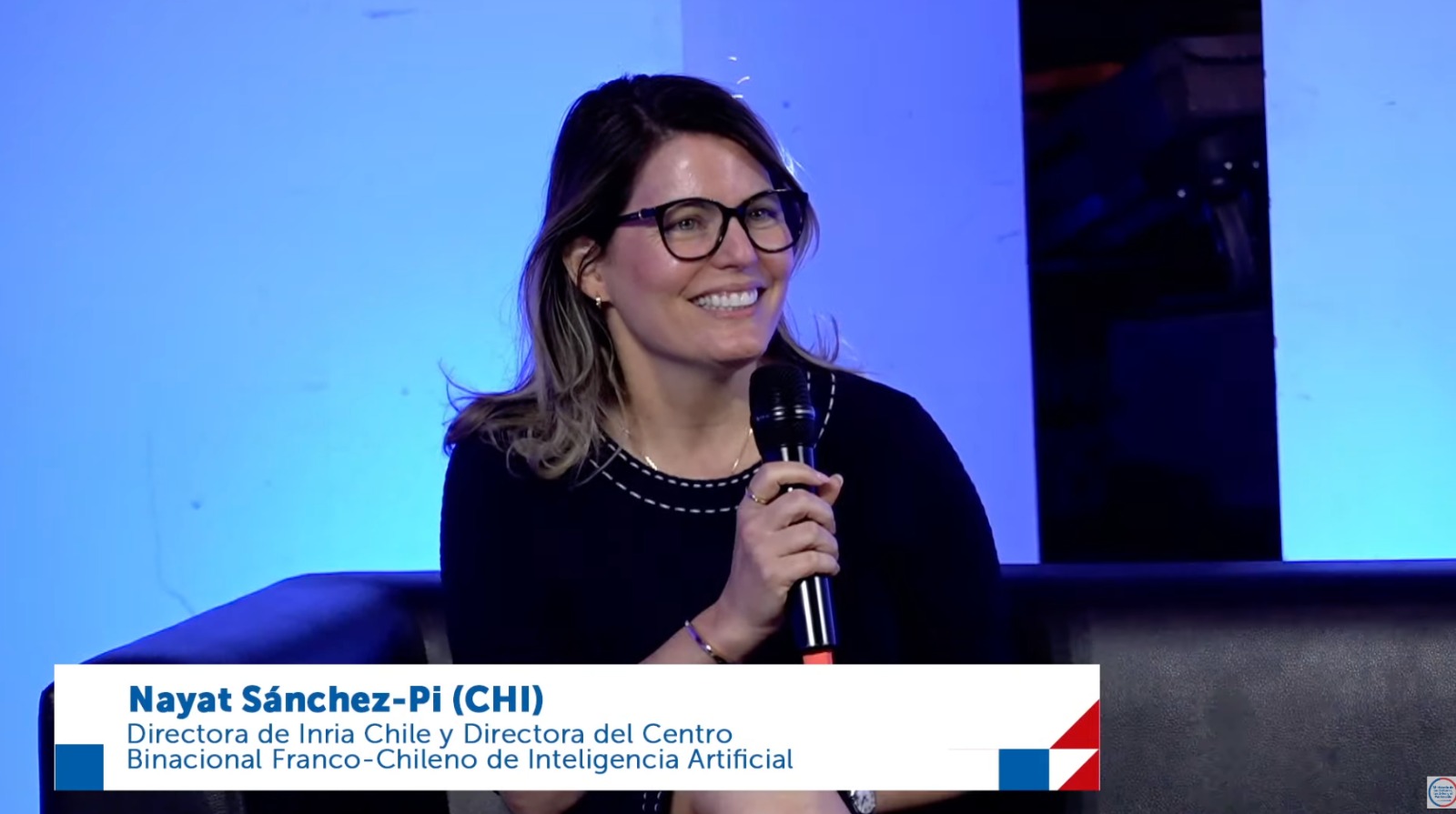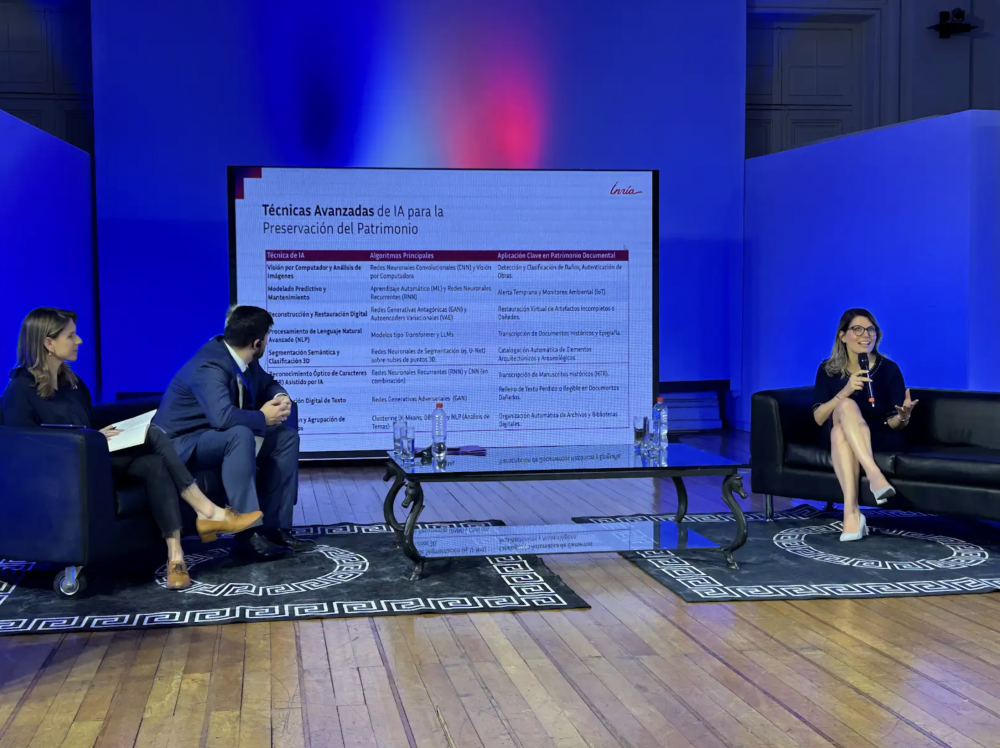
From 6 to 9 October, Santiago hosted Rencontres Malraux 2025, an international meeting that brought together representatives from France and Chile to deepen scientific and cultural cooperation. This year’s edition focused on “Artificial Intelligence and Heritage”, a theme that prompted dialogues on how digital technologies — and, in particular, artificial intelligence — relate to the preservation and enhancement of heritage.
Within the programme — organised by Chile’s Ministry of Cultures, Arts and Heritage and France’s Ministry of Culture — Nayat Sánchez-Pi, Director of Inria Chile and of the Franco-Chilean Binational Center on Artificial Intelligence, gave a talk entitled “Artificial Intelligence and Documentary Heritage: Preserving the Past, Building the Future.” Her presentation addressed the challenges of the digital age for cultural heritage and set out the potential of artificial intelligence as a tool for its protection and dissemination.
In conversation with Jean-François Moufflet, Head of Heritage in the Department of the Middle Ages and the Ancien Régime at the French National Archives — who spoke about the use of artificial intelligence in document digitisation — alongside Daniela Serra from Chile’s Under-secretariat of Heritage, Sánchez-Pi began by stressing the importance of documentary heritage, citing UNESCO’s definition that describes it as “the testimony to the evolution of thought, of discoveries and of the achievements of society.” She underlined that this legacy — spanning from ancient manuscripts to software and digital data — constitutes humanity’s collective memory and an indispensable source of knowledge for the future.
The challenges of the digital age and the impact of AI
The Director of Inria Chile and Director of the Franco-Chilean Binational Center on Artificial Intelligence explained that, while artificial intelligence has a history intertwined with the development of computing since the 1940s, today it has a dual impact. On the one hand, it offers tools to accelerate processes and democratise access to knowledge; on the other, it entails risks such as the spread of errors and biases, the misuse of information, and its own environmental footprint.
In the digital age, heritage faces monumental challenges: the massive volume of data, the fragility of digital media, hardware and software obsolescence, decipherment, and the heterogeneity of formats and languages. “There are many challenges in the digital age that are shared not only in the cultural environment and heritage preservation, but across all sectors of the economy and society. They have to do with the explosion of information and the quantity of data we have been accumulating for millennia, driven by sensorisation and the paradigm of mobile computing, among other technologies,” Sánchez-Pi noted.
Inria: cutting-edge projects that bring together AI and heritage
To illustrate the potential of artificial intelligence, six concrete projects developed by Inria teams in France were presented, where interdisciplinary collaboration is the key factor in their success. Highlights include:
-
Back in Time: An initiative that combines cryptography, history and artificial intelligence to decipher ancient manuscripts. Its best-known achievement is the decipherment of a letter from Emperor Charles V that remained encrypted for 500 years, thanks to a model trained to recognise unknown symbols.
-
Apollon: This project uses artificial intelligence to analyse Aristotle’s Politics and thus understand key notions such as “democracy” or “tyranny” in their original context. By analysing the text in Ancient Greek, the initiative tackles the challenge of data scarcity, requiring a transparent process with expert oversight to ensure rigorous interpretation.
-
La Coupole: A project focused on the digitisation of heritage objects with high visual and geometric fidelity. Using a robotic arm and high-resolution scanners, it creates digital replicas that capture textures, colours and reflections with unprecedented realism, enabling study and virtual display.
-
Polifonía: This initiative explores Europe’s musical heritage to reveal cultural and social links between countries through their music. It uses knowledge graphs and artificial intelligence to analyse musical similarity, manage scores and perform automatic transcription across a corpus ranging from the Renaissance to the present day.
-
Parthenos: Focused on creating an integrated, standardised digital environment for research in the humanities and cultural heritage. Its aim is to overcome methodological fragmentation by aligning practices across different European research infrastructures. To this end, it developed the Standardisation Survival Kit (SSK), a platform that offers researchers step-by-step methods and resources to handle data of various kinds (text, image, 3D), ensuring that digital heritage is archived in a reusable and sustainable way.
-
Software Heritage: Considered “the Library of Alexandria of source code,” it is a universal mission to collect, preserve and share all open-source software ever written. This Inria initiative, supported by UNESCO, archives digital heritage of crucial importance for humanity, such as the code from the Apollo 11 space mission.
“Applying artificial intelligence to documentary heritage is a challenge that brings many demands. The first is interdisciplinary work; without this alliance, this convergence, successful results would not be possible. The second message is the importance of sharing, because part of preserving heritage — and in particular of digitising it — is precisely to enable a way to share it”
The future and the role of the Franco-Chilean Binational Center on AI
The Director concluded her presentation by emphasising that the future of artificial intelligence in documentary heritage lies in predictive conservation, semantic understanding of content, and creating more inclusive and interactive access. In this context, the Franco-Chilean Binational Center on Artificial Intelligence, created in 2024, positions itself as a bridge between Europe and Latin America to drive artificial-intelligence projects for the common good.
Verbatim
The agreement, signed between the governments of France and Chile and which establishes the Franco-Chilean Binational Center on Artificial Intelligence, seeks to bring together complementary strengths between countries that today lead artificial intelligence within their respective regions. Those complementary strengths come from Europe and Latin America and, in this case, from France and Chile. Through this Center, we have three challenges: first, to ensure artificial intelligence that is safe for the common good — which clearly encompasses heritage and the social sciences; second, to develop artificial intelligence in the service of science and sustainable development; and third, artificial intelligence in the service of innovation and public policy.
Director of Inria Chile / Director of the Franco-Chilean Binational Center on Artificial Intelligence

